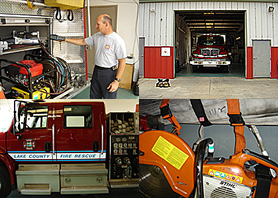RFID equipment tracking
RFID equipment tracking. Radio frequency identification ( RFID) equipment tool tracking refers to the use of radio waves to identify and track equipment or objects. The data from the equipment is transferred through radio waves to a reader for the purpose of locating the object. It is possible to read some RFID tags several meters away, even if it is not in the line of sight of the reader. RFID is being used in several applications such as hospital equipment tracking, tool tracking for mobile services, locating forklift, tracking fire station equipment, etc.
 RFID equipment tracking is critical to a company’s bottom line. The company’s capability to access tool and equipment information as regards location and status instantly contributes greatly to the successful completion of a project. It is possible to implement a cost-effective automated data collection system in day-to-day operations with the help of RFID technology. In order to implement the system, each piece of equipment will have to be tagged and RFID readers, fixed or mobile, have to be made available at suitable locations. Some of the applications of RFID equipment tracking are discussed in this article.
RFID equipment tracking is critical to a company’s bottom line. The company’s capability to access tool and equipment information as regards location and status instantly contributes greatly to the successful completion of a project. It is possible to implement a cost-effective automated data collection system in day-to-day operations with the help of RFID technology. In order to implement the system, each piece of equipment will have to be tagged and RFID readers, fixed or mobile, have to be made available at suitable locations. Some of the applications of RFID equipment tracking are discussed in this article.
Hospitals have always had problems with tracking equipment and assets. Typically these problems include the labor costs involved in searching for the equipment when it is required, loss of time due to the non-availability of the equipment as required, higher inventory costs due to purchase or hiring of equipment as a result of lack of availability and frustration of the staff that leads to inefficiencies in operation.
It is important for many construction, HVAC contractors and repair service companies having many vans to keep count of their expensive tools.
In large warehouses, there is always the need to locate a special forklift for a specific use. All forklifts are not manned and will not be available just like that. Many a time it is difficult to find a forklift and assign it for a job. The efficiency of operation of a warehouse can be tremendously improved by implementing the RFID equipment tracking system.
All fire stations are required to maintain apparatus inventory to enable delivery of essential services. To abide by regulation, it is necessary to stock equipment and consumables. However, it becomes a difficult to track equipment as they are continuously being inspected and placed in or out of active status. Additionally, equipment is also exchanged with other fire stations. The RFID asset tracking arrangement will be of great help to sort out their problems.
The RFID equipment tracking system will definitely help companies sort out their equipment tracking problems. RFID tags can be put on the equipment or asset. The RFID technologies that are available are:
o Passive and Active Real Time Location Services or RLTS
o Hybrid technology that uses sensors and integrated solutions
Passive tags such as bar code systems require the services of a person to manually scan a tag or a label to capture the data. If the tool is dirty, the barcode reader may not sense properly. A lot time and cost will be involved in handling such issues. On the other hand, active tags transmit data or information about location automatically. Since an active tag can detect movement, tampering, or environmental conditions with the help of sensors included in the tags, theft or pilferage can be prevented.
To set up RFID equipment tracking suitable for a particular application, the pros and cons of the available technologies should be assessed before implementing the project.

